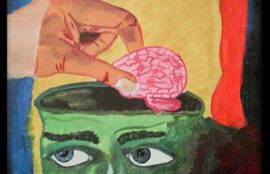
Here is a non-exhaustive list of things that have made me cry: Any time I must chop, dice, or mince ingredients; a group of sea lions barking in the sun; sad music; receiving a free hot dog; the film 500 Days of Summer; a messy house.
The one emotion tying all of these experiences together, according to Ad Vingerhoets, an emeritus professor at Tilburg University and one of the world’s preeminent experts on crying, is a sense of powerlessness. Even in the context of positive tear-jerking events — like encountering a very small puppy or watching your best friend walk down the aisle at their wedding — there is a feeling of overwhelm, Vingerhoets says. “You also feel small and helpless and humble,” he says.
Humans come into the world crying, and we never really stop. As babies, we cry in order to get attention from our parents, signaling to them that we’re angry or scared or in pain or hungry or tired. In childhood and adolescence, we cry from physical pain, like a scraped knee, but as we develop empathy in our teenage years, external catalysts — like books, movies, and other people’s pain — elicit tears. As we get older, we may be moved to tears by beauty, awe, wonder, and sentimentality, says Lauren Bylsma, an associate professor of psychiatry and psychology at the University of Pittsburgh.
For some people, the well of tears has run dry. The stereotype that criers are seen as weaker or less masculine contributes to the well-trodden notion that boys (and men) don’t cry. Indeed, women report crying more frequently than men and with shorter gaps in between crying episodes than men. Then, there’s that thorny feeling of vulnerability associated with sobbing; to betray the veneer of stoicism is deeply uncomfortable for some, to admit you need help can be seen as a failure.
But have you ever stopped to consider why you’re crying? The root cause of the sadness or overwhelm? What about what you can learn from your tears? Mining the depths of your emotions can shed light on deeper insecurities, fears, pleasures, and relationship complications.
What our tears tell us
The presence of tears signals one basic message, says Randolph Cornelius, a professor of psychological science at Vassar College: I need help. “We’re asking other people to aid us,” he says. Research suggests tears are so effective at eliciting help because criers are seen as sadder, more helpless, less aggressive, and in need of interpersonal connection. According to one of Vingerhoets’ 2017 studies, people are more likely to offer help to a crying person compared to just a sad person with a dry face. “Recognizing that people [are] crying and in need of help is a pretty automatic process,” Cornelius says.
Throughout the entire lifespan, some of the most common triggers of tears, Vingerhoets says, are bereavement, heartache, and homesickness. (Though women do cry more often in general over more mundane and conflict-driven situations, “the difference between the sexes is not that big” when it comes to these main motivators of crying, Vingerhoets says.) Then there are the positive cries: Weeping not just over a separation, but a reunion; crying out of relief and not fear; shedding tears when receiving a gift, not only when having it taken away. “All of these negative situations that provoked tears, they all seem to have their opposite,” Vingerhoets says, “which also induces tears.”
We receive the most support when we cry in front of a partner or a friend, Bylsma says, someone who is best equipped to console and emotionally support us. Research shows that the presence of visible tears can also bring people closer together and promote social bonding. “If you are stressed, it’s important that you receive social support from others,” Vingerhoets says, “because that can buffer the negative effects of stress on your well-being.”
Subliminally or not, we may realize that turning on the waterworks gets us what we want. “I have a 10-year-old grandson and he can turn crying on and off,” Cornelius says. “Kids learn how to manipulate adults and so that stays with us.” Much has been written about the weaponization of tears, especially by white women, in order to protect privilege and garner sympathy. Research finds that fake criers are seen as manipulative, less reliable, less warm, less competent, and less accepted as friends, colleagues, or neighbors. But usually, Cornelius says, adults keep their tears in check, having learned the socially appropriate places to cry (in private, on the side of the road when you have a flat tire) and opting not to cry at our desks at work when we feel frustrated. That is, unless the situation is uniquely overwhelming, Cornelius says, like in the face of an unexpected tragedy.
Why the context of the cry matters
Popular convention maintains that crying is a cathartic experience, that we feel cleansed and weightless following a good weep. “That’s not always the case,” Bylsma says, “and it really depends on various contextual factors.” We’re likely to reap the most benefit from crying if we can shed a few tears in a safe place, Bylsma says. “We found in research if someone were to cry in a place where it might be embarrassing, where people might react in a negative way, like crying in front of people you don’t know well in a workplace setting, for example, someone’s going to feel worse after crying,” she says, “versus if you cry in a more supportive environment, like in front of a partner or friend that you’re more likely to have a benefit from.”
In one of Vingerhoets’ and Bylsma’s studies, they found that people who are depressed, anxious, or experiencing burnout cry more, but they did not feel relief after crying. Those who felt shame and embarrassment were less likely to feel better following a cry, too. People find more catharsis after crying when the situation that made them weepy was controllable — like a fight with their partner — as opposed to an uncontrollable event, like a death.
Bylsma also notes that chronically suppressing tears is associated with negative emotional effects, like less empathy and emotional support, based on surveys. So if you feel the need to cry in the middle of a work meeting, try to get yourself to a bathroom and let it out. On the contrary, for those who have no reason to cry and forgo weeping for a long time, even years, there’s no harm in that, Vingerhoets says. However, persistent bouts of crying and ruminating over the same issues might be a sign you need to change your approach to crying, Bylsma says. Try seeking the help of a therapist or mental health professional who can help you cope.
What crying reveals
Regardless of what made you cry, whether it be a sad movie or a beautiful sunset, there is a deeper meaning. The presence of tears reveals what matters to you. “Sometimes our tears are signals to ourselves about the significance of events,” Cornelius says.
Consider the last time you cried. Was it an argument? An exhausting day? A delicious cupcake? What about those situations stirred up emotions? In the moment of the crying episode, try to process what, exactly, is making you cry, Cornelius says. “We do have an inner drive to know ourselves,” he says. “I think recognizing our emotions, giving them their due, allows us to do that.” Over time, you may recognize patterns in your emotions: I feel resentful in these situations, those comments make me feel embarrassed.
Having this bit of insight can help you reframe the situation: This isn’t an argument about taking out the trash, it’s an argument about respect. Sometimes tears can help reveal these underlying messages.
“When you have a realization about yourself, and that allows you to see yourself in a different way, you do feel empowered,” Cornelius says.
Original article here






















Sorry, the comment form is closed at this time.